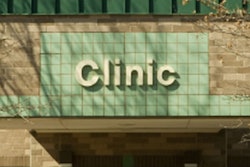
Patients are becoming increasingly sophisticated about healthcare services, using social media or online searches to get information -- particularly cost -- about imaging exams or procedures. But are they getting what they pay for? Maybe not.
Medical imaging can be expensive, and identical examinations have different prices depending on the imaging center, said Dr. Ankur Doshi of NYU Langone Medical Center, who presented on the topic at RSNA 2016 in Chicago. Because patients' out-of-pocket expenses for medical care continue to increase, they're looking for ways to evaluate the cost of imaging services.
 Dr. Ankur Doshi from NYU Langone Medical Center.
Dr. Ankur Doshi from NYU Langone Medical Center.But going with the cheapest option isn't always the best plan, Doshi told AuntMinnie.com.
"If patients make decisions based on price, they may be at risk of sacrificing quality, because nobody really knows if lower-priced imaging is in fact associated with maintained levels of quality," he said.
For the study, Doshi and colleagues searched OkCopay.com, a website that provides the cost of medical services, to identify the prices patients pay for brain MRI, abdominopelvic CT, and pelvic ultrasound exams. At the time of the study, OkCopay.com had data for 16 U.S. cities.
The researchers also searched Yelp.com to investigate overall satisfaction scores from patient reviews for the corresponding imaging centers. Imaging centers were included if they were nonhospital-based, if the cost information from OkCopay.com for a particular exam offered at the center included both professional and technical fees, and if the center had at least three patient reviews on Yelp.com.
The team included information from 98 imaging centers, which provided data from 87 brain MRI scans, 72 abdominopelvic CT studies, and 65 pelvic ultrasound exams. Doshi and colleagues calculated the mean cost of these exams at individual imaging centers according to OkCopay, and then correlated the mean cost with the mean Yelp scores for the center.
The relationship was rendered in terms of the correlation coefficient r, with higher r values indicating a stronger relationship between price and patient satisfaction. Most of the r values were in the range of a weak positive relationship that was statistically significant.
| Correlation between cost and patient satisfaction in imaging | |||
| Mean cost | Cost range | r value | |
| Brain MRI | $725 | $250 to $3,129 | 0.224 |
| Abdominopelvic CT | $467 | $190 to $3,117 | 0.248 |
| Pelvic ultrasound | $256 | $80 to $1,000 | 0.376 |
The mean number of Yelp reviews per imaging center was 13 (range, 3-59). The mean Yelp rating was 2.97 out of a scale of 1 to 5.
"For all three imaging exams, price and Yelp scores exhibited weak, albeit statistically significant, positive correlations," Doshi said. "Thus, an imaging center selected based on a low price may be associated with poorer patient satisfaction."
However, because pricing is based on a number of factors, a center's low imaging cost could be influenced by its imaging equipment, by negotiated reimbursement rates with insurance companies, or even by patient volume, according to Doshi.
"A purely speculative possibility for our findings is that imaging centers that are able to offer lower prices may have a larger volume of patients," he said.
What's the real bottom line? Patients should be cautious when shopping for radiology services by using price as the deciding factor, and radiologists should probably track ratings websites, according to Doshi.
"Patients should seek the source of data when visiting these sites, and imaging centers should also visit these sites to verify if the data is accurate," he told AuntMinnie.com. "Radiologists must reinforce the importance of quality and patient experience, and work on developing better-defined, meaningful quality metrics so that patients can make more informed decisions that are not based solely on price."




















